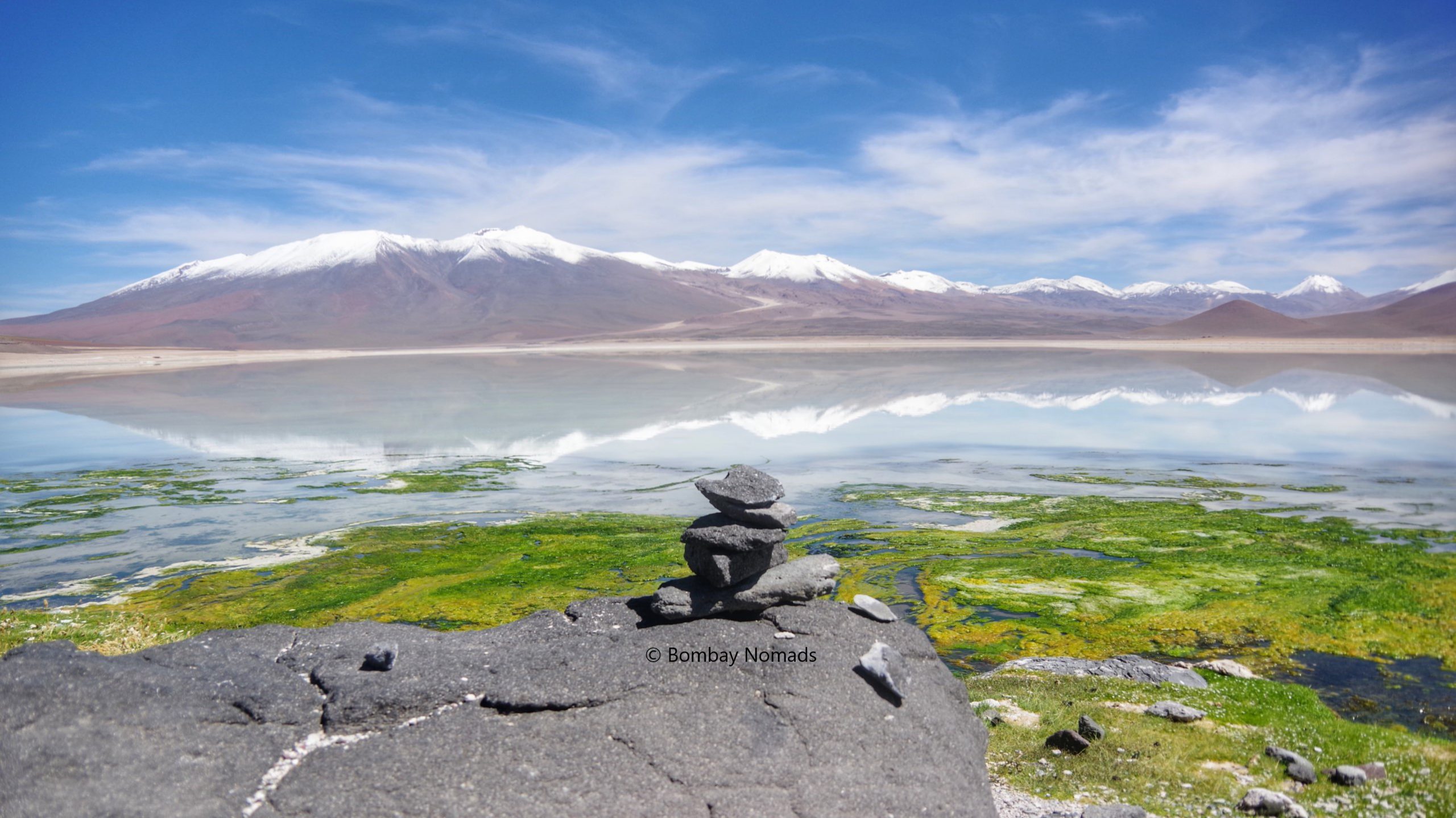Resuming our South American posts after a long gap
The posts from South America are more descriptive and detail oriented, to help other travellers who are planning their own travels to the continent, get a better idea of what to expect
While the beauty of the Atacama desert around San Pedro de Atacama (SPdA) mesmerized us, it was only a sneak peak into the magnum opus, that is Reserva Nacional de Fauna Andina Eduardo Avaroa (Eduardo Avaroa National Reserve) in southern Bolivia. It lies to the south of Salar de Uyuni – the largest salt flat in the world and one of the most extraordinary places on this earth. The altiplanic landscape of Eduardo Avaroa National Reserve is another level of stunning, which will leave you breathless both figuratively and literally. Because of the, you know, 4500+m altitude.
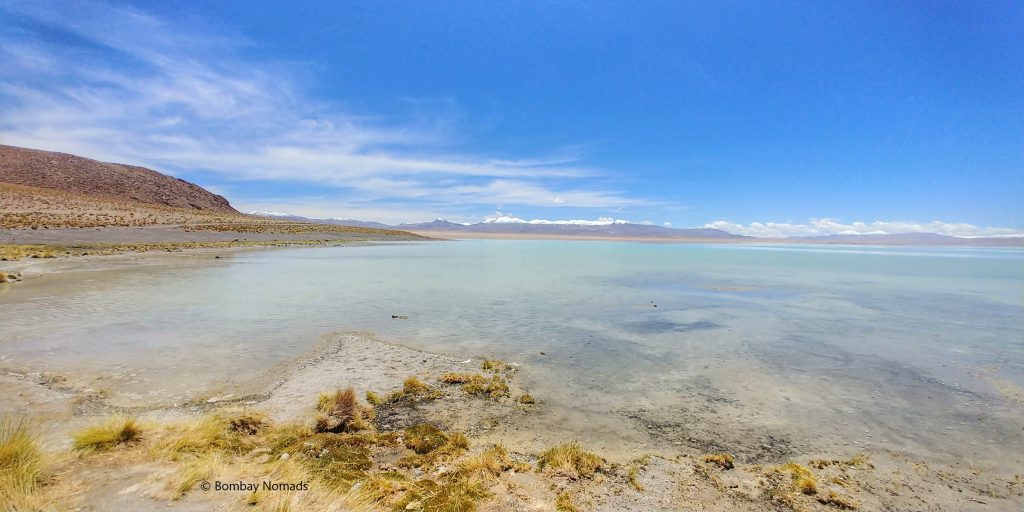
We had read about the Salar de Uyuni, so we knew what to expect – although the scale of the place blows any expectation into smithereens. But we had never heard about Eduardo Avaroa National Reserve, and were completely unprepared for the awe-inspiring beauty that was to follow.
Eduardo Avaroa National Reserve is a stark and monumental landscape of high altitude desert, rainbow coloured lakes, eroded and twisted rocks, geysers and hot springs, spectacular 6,000+m volcanoes and an absurd number of flamingos. The reserve is in the southernmost corner of Bolivia, along the borders with Chile and Argentina. The whole park is situated in the Bolivian altiplano, the second highest plateau of the world (after Tibet), and is upwards of 4,500m. There are no roads inside the reserve and the only way to travel is on dirt roads using 4WD vehicles. We followed what is referred to as the Lagunas Route.
How to Reach
The only way to see Eduardo Avaroa National Reserve and Salar de Uyuni is by hiring tourist SUVs, unless one is comfortable driving 4WDs themselves. No buses or any public transport operate in this region. There are innumerable agencies offering 2 or 3 day Uyuni tours – which include both the Uyuni salt flats and Eduardo Avaroa National Reserve. The tours start from the town of Uyuni in Bolivia as well as San Pedro de Atacama (SPdA) in Chile. From SPdA, a minibus will collect the passengers and drop them to the Hito Cajon border post between Chile and Bolivia, where a queue of Bolivian 4WD SUVs are waiting on the other side.
How to choose a tour operator is THE tricky decision. The default configuration is 6 passengers plus driver in a large SUV – a Toyota Landcruiser or a Nissan Patrol. The overnight stays would be in basic hotels with shared rooms (with bunk beds), shared toilets and no guaranteed showers. But it would be cheapest option at USD 180-250 per head*. Some people have had decent experiences and others have complained a bit (lot) about the conditions. You could get it at even lower prices, if you shop around for a spot booking the day before departure.
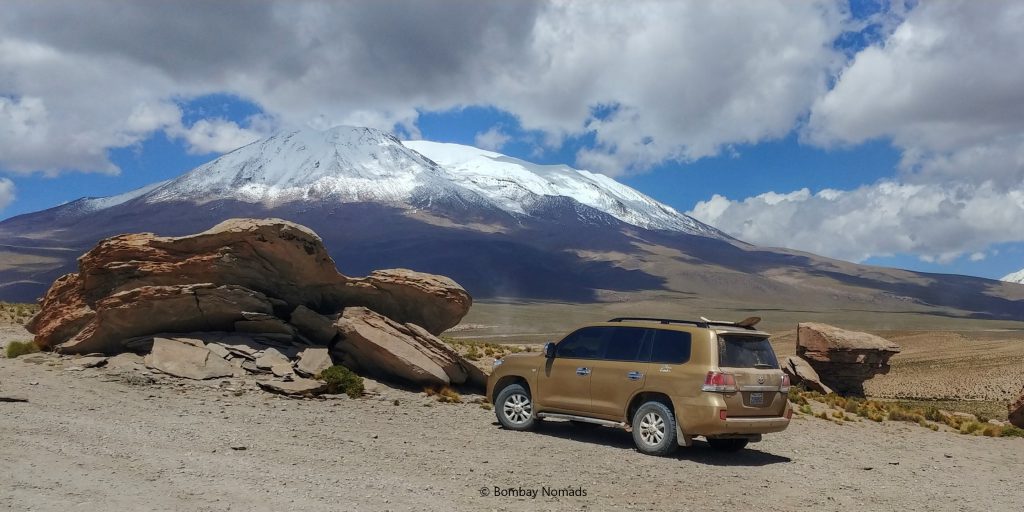
We like planning ahead, so not having a confirmed booking wasn’t really an option. We also value our creature comforts, so we decided to go with the best rated tour agency (Creative Tours) and chose a private ensuite room in Tayka hotels (Tayka hotels are known to be best in the Salar region). We ended up paying a hefty USD 650 per person* for a 4 passengers configuration. However, the other two passengers cancelled, so we ended up having the whole SUV for ourselves.
* all prices as of Feb 2019
Departure from San Pedro de Atacama & crossing into Bolivia
As it kept happening on our trip , we were the first to be picked up by the minibus. The pickup was scheduled to happen by 07:00, but was delayed by half an hour. After collecting other passengers, we headed out on Ruta 27 and turned towards Hito Cajon border post. But all the buses lined up and stopped a couple of km away from the border crossing. There were about 2 dozen vehicles, and all of them proceeded to lay out picnic tables on the side of the road itself.
There was rustic bread, cheese slices, cold cut ham, mushed avocado (done in front of us) and sliced cake laid out on our table. The bread was somewhat hard, but we were hungry so we didn’t mind. It was a cold day and the hot coffee was especially welcome. The border post probably opens at 09:00, because we stayed stationary from 08:00 to 09:00.
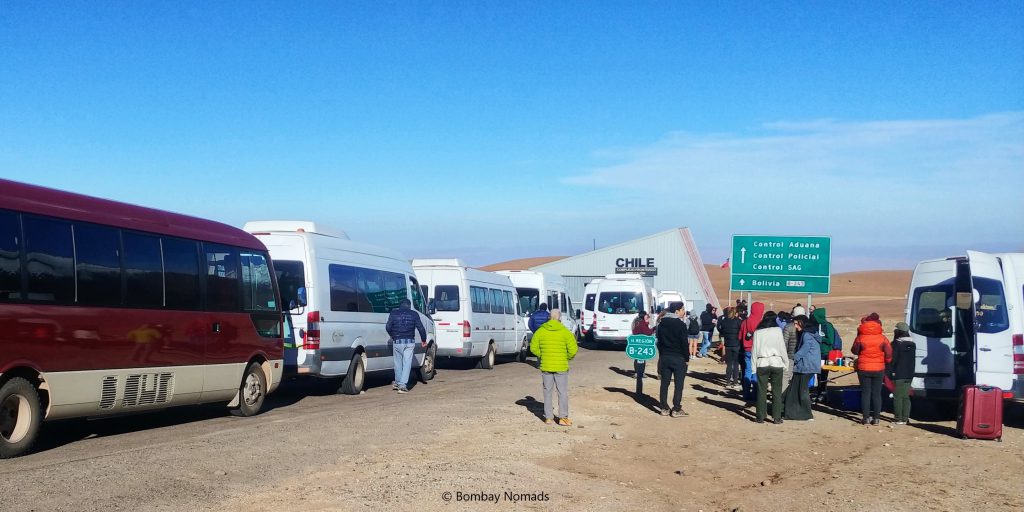
The Chile border station at Hito Cajon was a bit different from the ones we had experienced so far. There is a large structure, where 2-3 vehicles were taken in. Then both inlet and outlet gates were closed and they weren’t opened till every passenger was processed. It was a quick process thankfully and we were out of the border station in 15 minutes.
A km away from the Chile border station was the Bolivian counterpart. Just like the border with Argentina, there was no fence or any visual marking of the border between the two countries. However, the contrast between the two countries couldn’t have been more stark. In a dusty open plain, stood a crumbling shed, surrounded by dozens of vehicles parked haphazardly. The passengers formed a queue outside the shed, and I got a feeling like I was in some govt office in rural india. We got delayed for a few minutes because of an entitled, credit-card-waving American backpacker, who neither had a Bolivian visa, nor enough dollars (or bolivianos) to pay the visa-on-arrival fees.
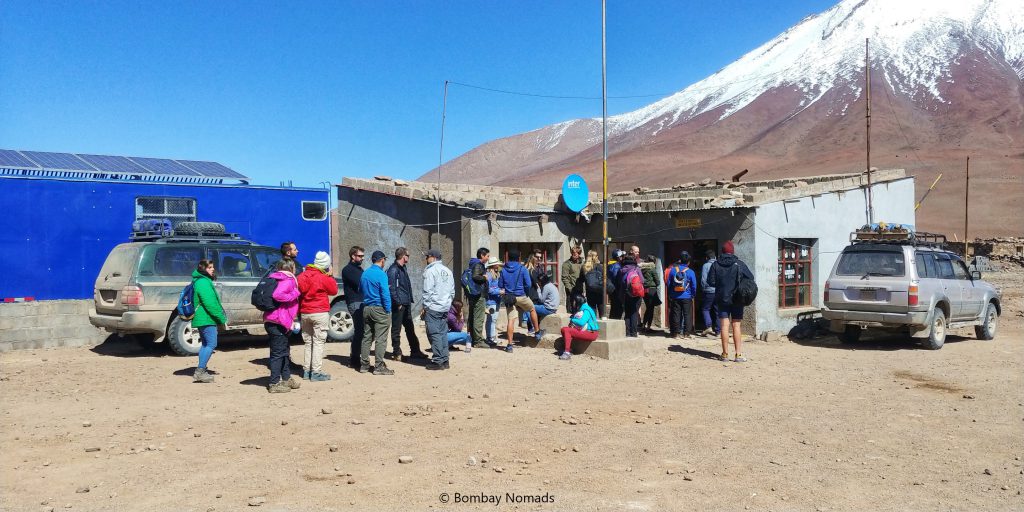
The stamping process was very quick thankfully (details about the Bolivian visa in our Santiago post). Soon we were outside, looking for our driver Juan. It took a while for everyone from SPdA to find their respective SUVs – and only when the crowds cleared a bit that we spotted Juan. He and his plush golden Toyota Landcruiser were going to be our companions for the next three days.
Laguna Blanca & Laguna Verde
The national reserve starts from the international boundary itself and within 10 minutes (just 2km away) from the Bolivian border post is Laguna Blanca. Most of the SUVs who started with us were already there. The saline lake resembled the antiplanic lagoons we had seen in SPdA, but the mirror-like reflections of the snow-capped mountains was something magical. We also bumped into an Indian-American couple at the lake, who we would keep meeting later.
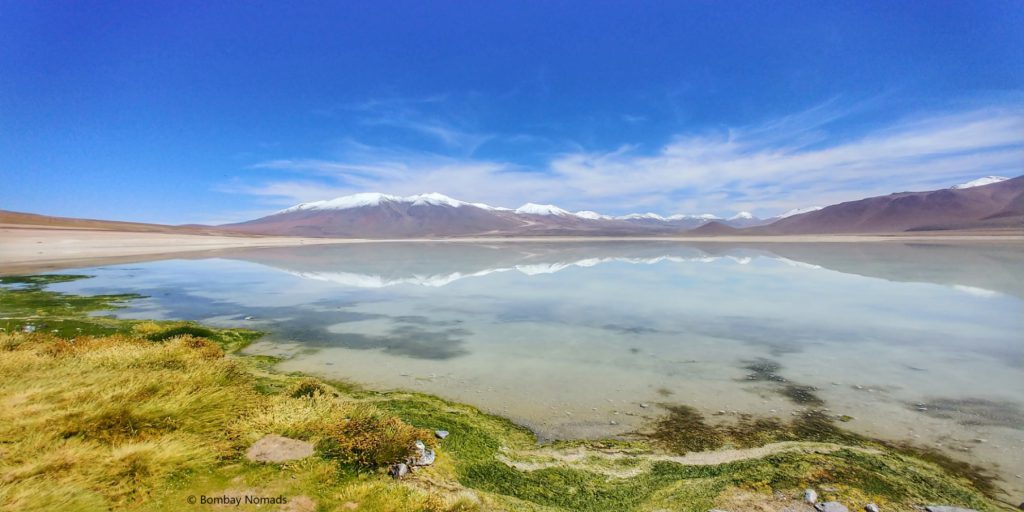
Back in our SUV, just another couple of km away was Laguna Verde. The waters had a oh-so-slight green tinge, but Juan assured us it looks greener in the afternoon. The lake was much smaller than Laguna Blanca, but the towering Mt Licancabur in the backdrop made it look like a postcard. Having seen a few antiplanic lagoons near SPdA, we can confirm that the lakes inside Eduardo Avaroa National Reserve are more enchanting and spellbinding.
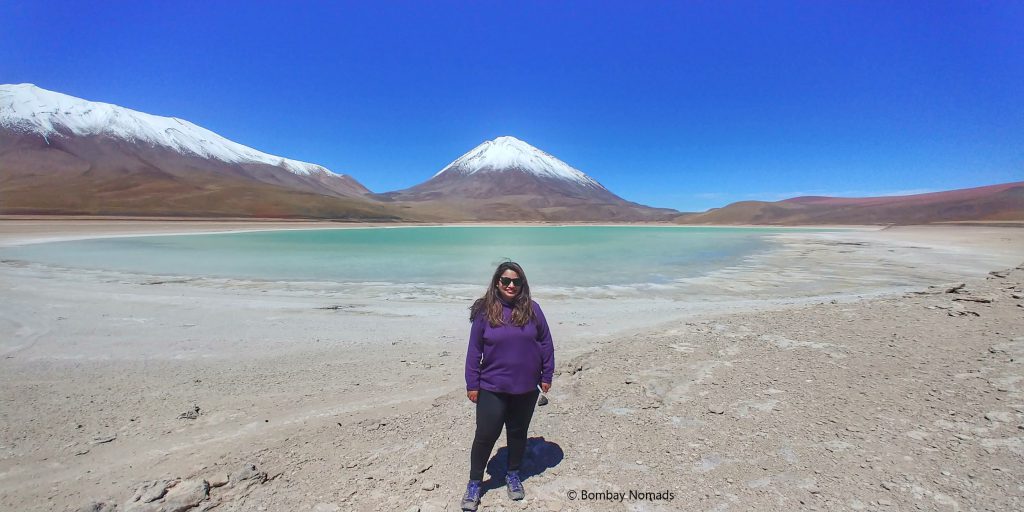
The sun was out strongly, but the winds and the high altitude made us zip up our jackets tighter and keep our hands wedged firmly inside the jacket pockets! Despite planning to capture every moment of the beautiful journey, once back in our SUV, our eyes grew heavy with the combined effect of waking up early and the high altitude, and we just couldn’t keep our eyes open. This always happens to us on high altitude mountain trips – like when we travelled to Ladakh or Spiti Valley.
Aguas Termales de Polques
We have come across a lot of picturesque hot springs during our travels (in South America and elsewhere), but Aguas Termales de Polques has downright one of the most picturesque locations. There is a small warm pool overlooking a greenish lake, with snow covered mountains in the distance. It is miles better (and cleaner) than the pool at El Tatio near SPdA. But the lack of a changing room and the cold wind dissuaded us from shedding our warm clothes.
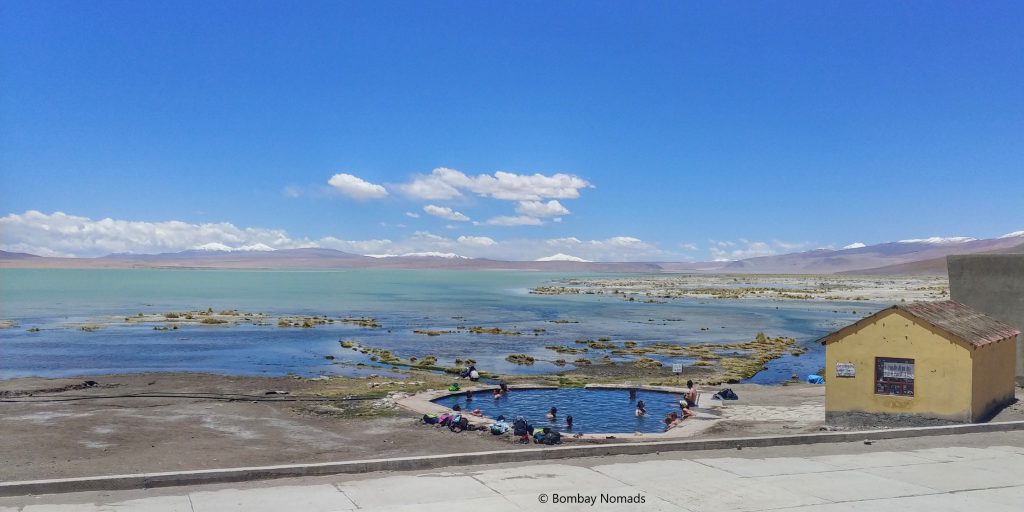
As it so happened, about 15 minutes after our arrival, a bunch of SUVs arrived at the hot springs and the new people completely crowded out the small pool. (even with no changing room, there was a charge for using the hot pool)
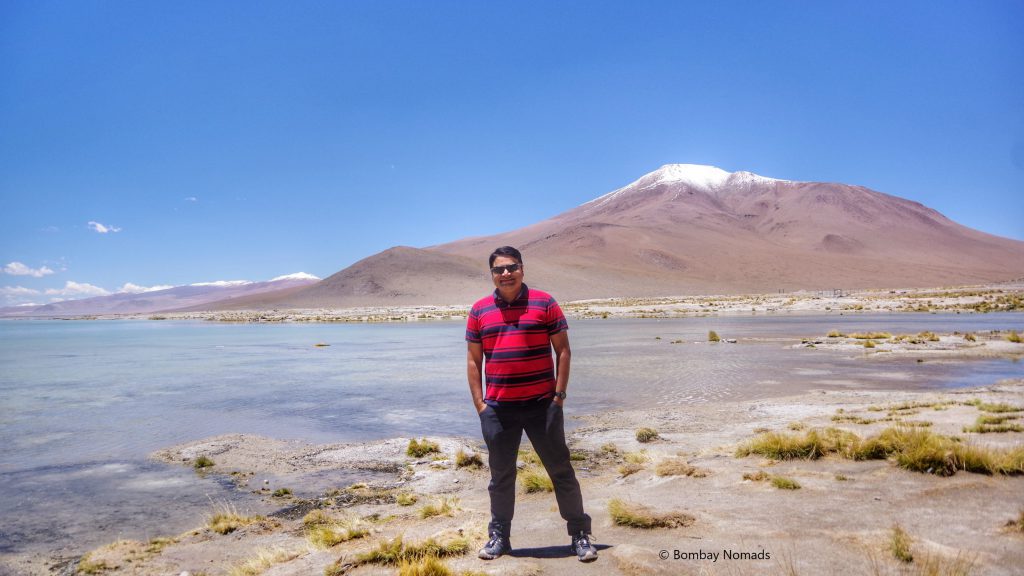
Instead, we just explored the lake shore a bit while Juan set up our lunch. The small cottage near the hot springs had a dining room setup with tables and chairs, but only served cold drinks and munchies – as cooking apparently isn’t allowed inside the park. Juan however, was carrying a fancy packed lunch for us in the car – big helpings of roast chicken and chicken milanesa (fried breaded chicken breasts), accompanied by pasta and three different salads. The salad with chicken and vinegar-soaked-veggies was especially good.
Sol de Mañana
The presence of hot springs presaged the geothermal field of Sol de Mañana. In a series of small depressions filled with fuming vents, steaming water and mud pools, Sol de Mañana is a reminder of the fiery, igneous origins of our planet. The colour of the mud pools and their surroundings ranged from grays to reds, yellows and even pink. Some were fuming angrily, while others seemed more placid, bubbling lazily. The telltale sulfurous smell was everpresent, which the strong wind couldnt completely blow away.
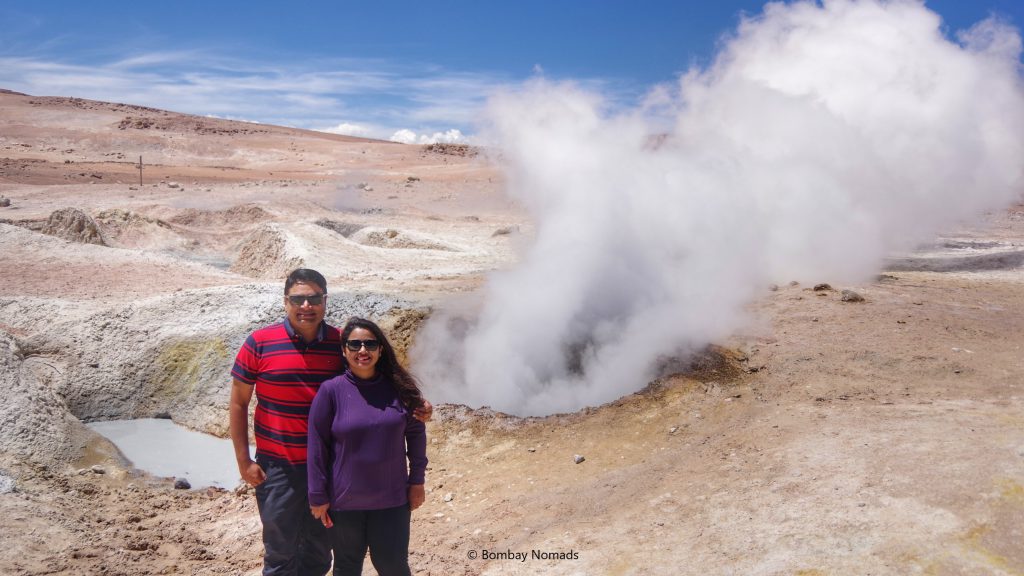
Worryingly, there are no barriers or well-marked paths for people to limit themselves to. We saw people walking where they pleased, jumping between boiling mud pools or getting too close to smoking vents. A lot of them seemed just one slip away from a nasty hot bath.
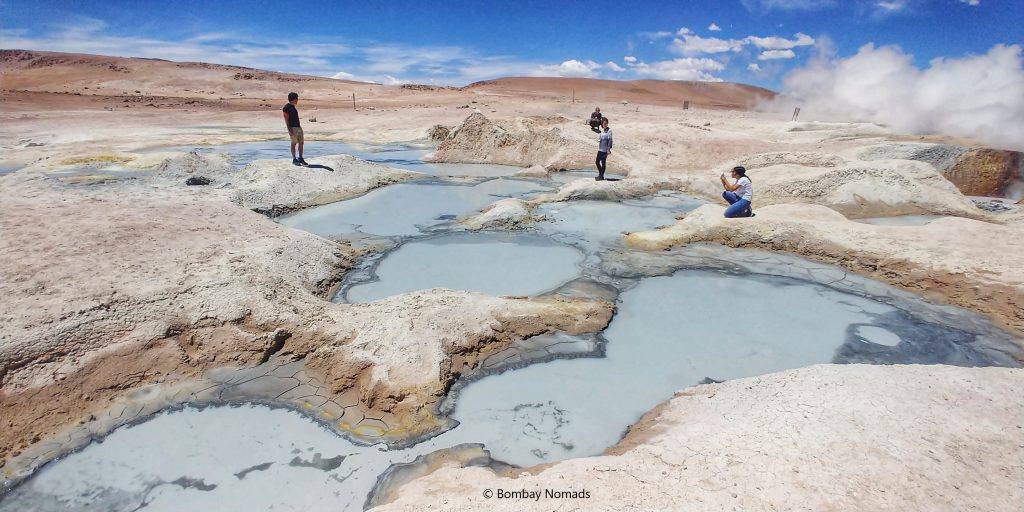
Laguna Colorado
Even in a dreamland filled with incredible natural wonders, the Laguna Colorado is the easily the most breathtaking part of Eduardo Avaroa National Park. An orangish-red lake, ringed with a tinge of green and speckled with patches of white borax minerals, surrounded by a gray/brown desert. It seems like some artist’s fertile imagination, till you see flocks of pink flamingos taking flight or landing on the lake. The water colour is the result of the salt-tolerant algae Dunaliella salina, which is also a giant buffet for flamingos. The result is an outer-worldly landscape that is spellbinding.
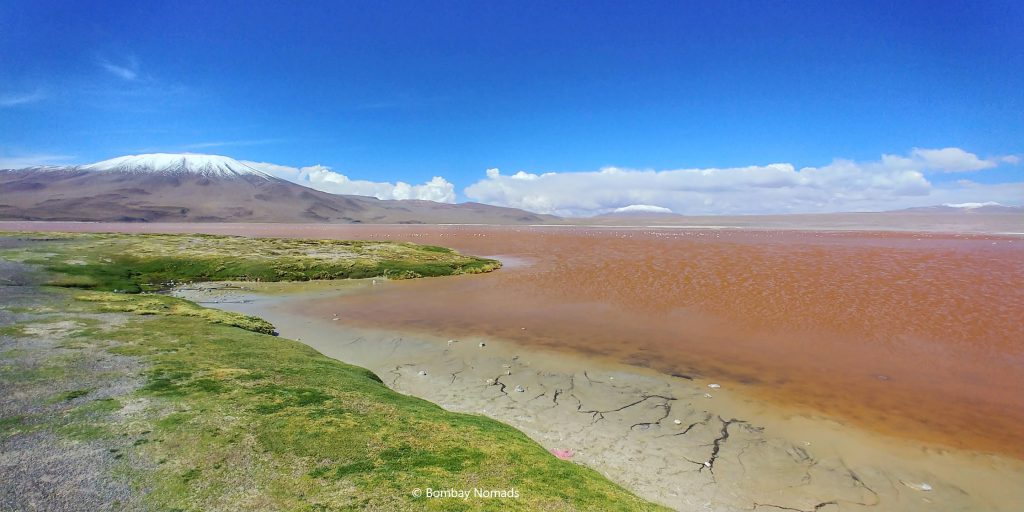
There is a viewing post built on the top of a nearby hill, although with the thin air makes it hard work. We spent more than an hour – on the hill and sitting on the shore of the lake – hoping some of the flamingos would approach closer. We were rewarded for our patience, as a small group of flamingos finally decided we humans were harmless enough and gave us some good close-up photos
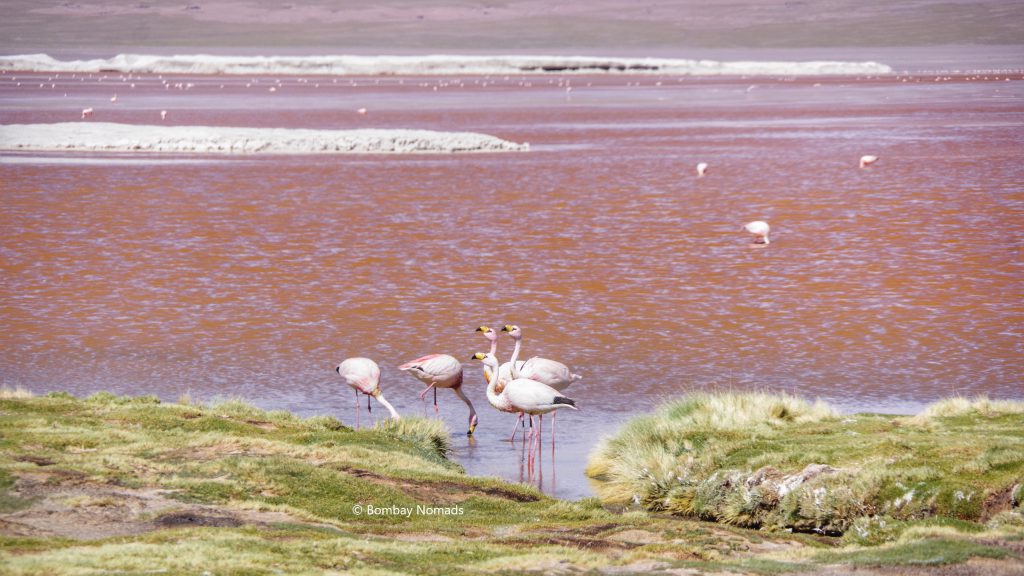
Árbol de Piedra
Árbol de Piedra (‘tree of stone’) is the most well-known of a series of eroded rocks in the Siloli desert. These sandstone rocks have been shaped into fantastic shapes by wind erosion. I would have loved to explore more of these fascinating structures, but we had to hurry back to our SUVs. The wind, which had been with us the entire day, had picked up into a howl now and stinging sand was all over our faces. This was the end of our first day in the Eduardo Avaroa National Reserve.
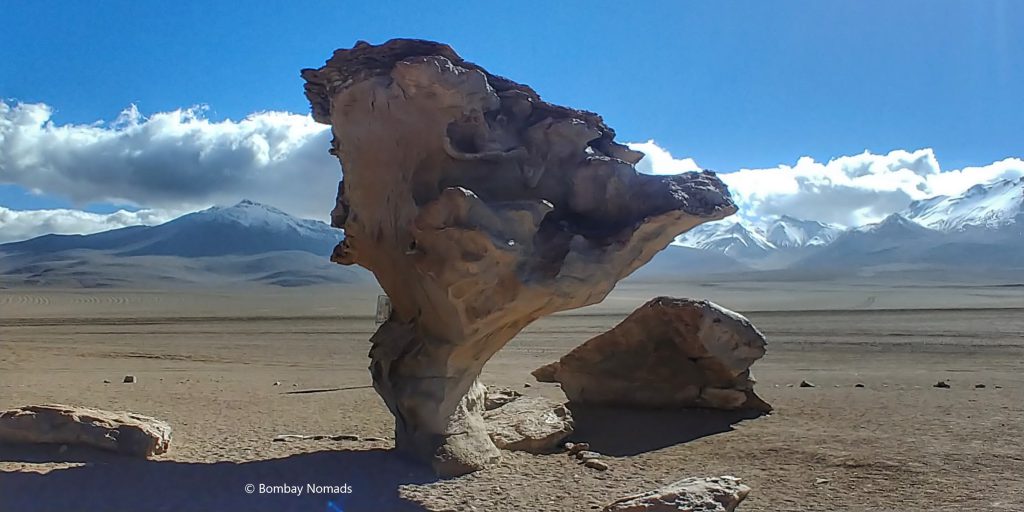
Day 2 : Laguna Cachi
We started our second day more comfortably, post breakfast, around 0845. Our first stop was Laguna Cachi, about half an hour away. Compared to the exquisite lakes yesterday, Laguna Cachi was a bit underwhelming. The water was missing the resplendent hues of the lakes yesterday, reflecting the grey-brown of the surrounding cliffs and the overcast skies above. The only special thing about the lake were the scores of pink flamingos feeding in it. Juan dropped us off at one point and waited ahead for us.
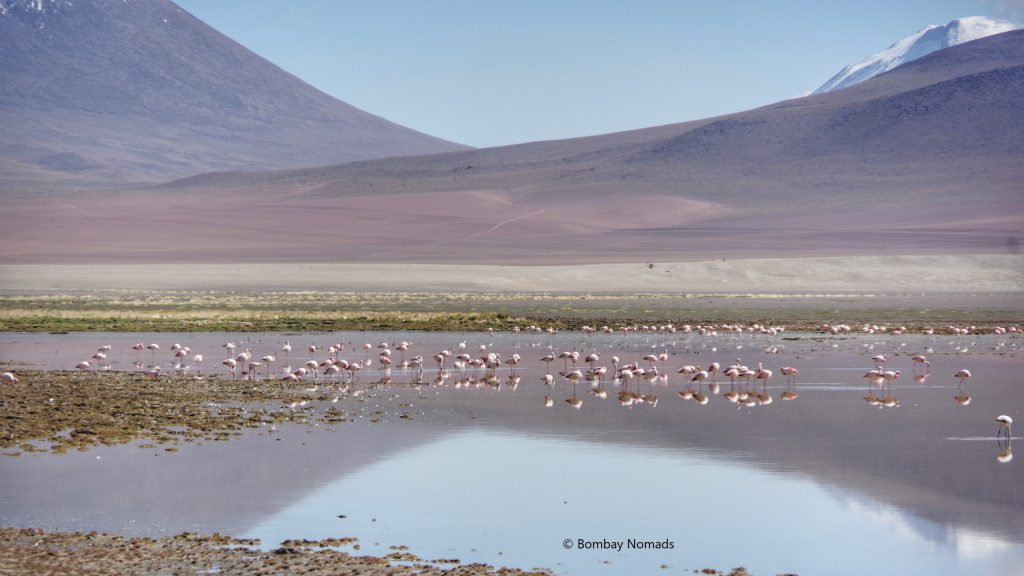
Walking on the shore of the lake was a bit tricky, as it was quite muddy near the shore, with spongy moss growing on it. However, I managed some good photos of the vibrant pink birds, all the while rueing not having a longer zoom lens with me. Also, the road was at some height from the lake shore. Even climbing that short distance resulted in a lot of exertion and heavy breathing!
Laguna Chulluncani
Not very far from Laguna Cachi – just half an hour away – was Laguna Chulluncani. It is an even smaller lake than Laguna Cachi. Set with the backdrop of the towering Chulluncani volcano, the lake was extremely calm and produced excellent mirror images of the snow capped peak and the clouds above.
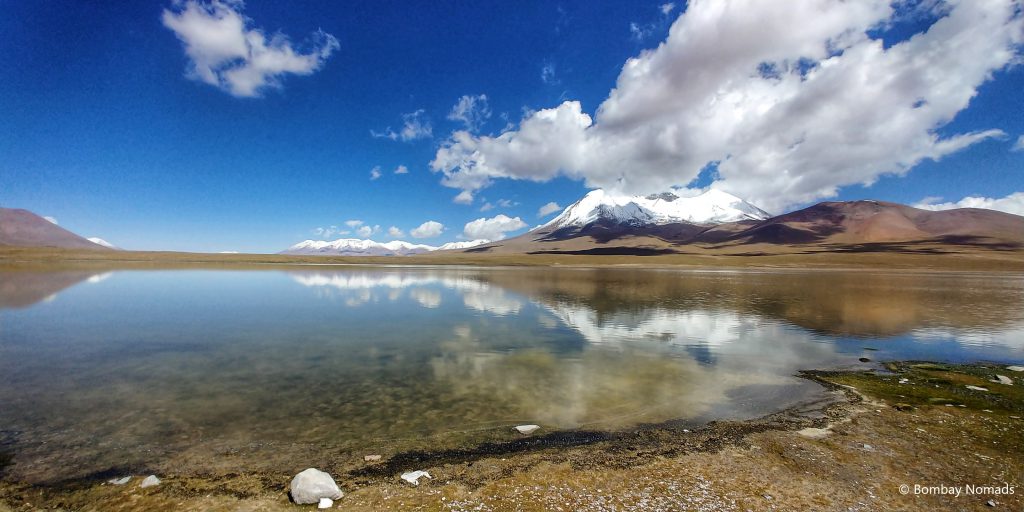
Laguna Turquiri
Another half an hour of driving brought us to Laguna Turquiri. We stopped at a high mirador (or a lookout), which stood set amidst wind-eroded rocks, overlooking the lake below. The green algae growing near the lake shores, produced a multi-hued water surface.
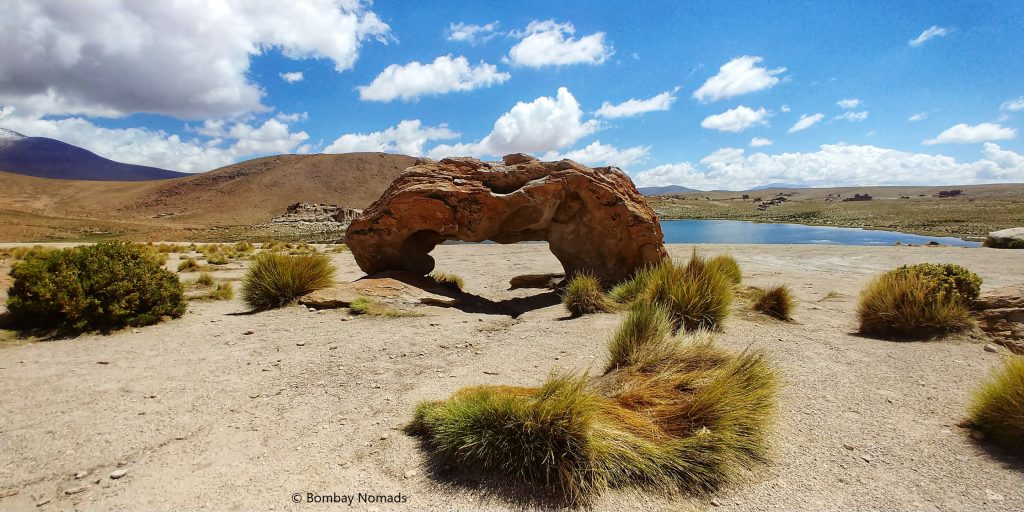
Also on the shores were a lot of yareta (pronounced ‘jareta’) plants. We had seen this plant thriving on Bridges Island in the cold moist Beagle Channel off Ushuaia. Surprisingly, this plant seems to thrive equally well in the desert-like conditions of the high antiplano.
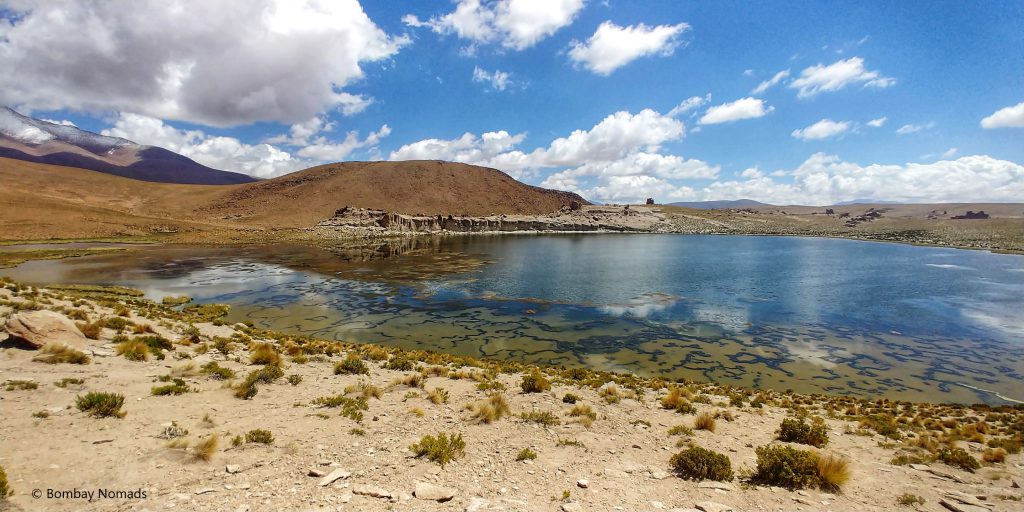
Another half an hour away was Laguna Canapa, but it seemed the lake had overflown (either with rains or snowmelt) and it had flooded the approach roads and left vast areas around it muddy. I and Juan got down from the car and tried to navigate our way through the mud to the lake, but gave up after a while. From what I could see, the water was very muddy and the lake wasnt worth the visit.
Mirador Volcán Ollagüe
Our lunch stop on the second day was at a small house (restaurant?) at Mirador Volcán Ollagüe. In the distance, we could see the active volcano Ollagüe, whose summit was emitting a small amount of white smoke!! We tried to hike our way to a better viewpoint of the volcano, but the effort at high altitude was too much for us. And although it was noon, the wind continued to be chilly and our jackets were fully zipped up.
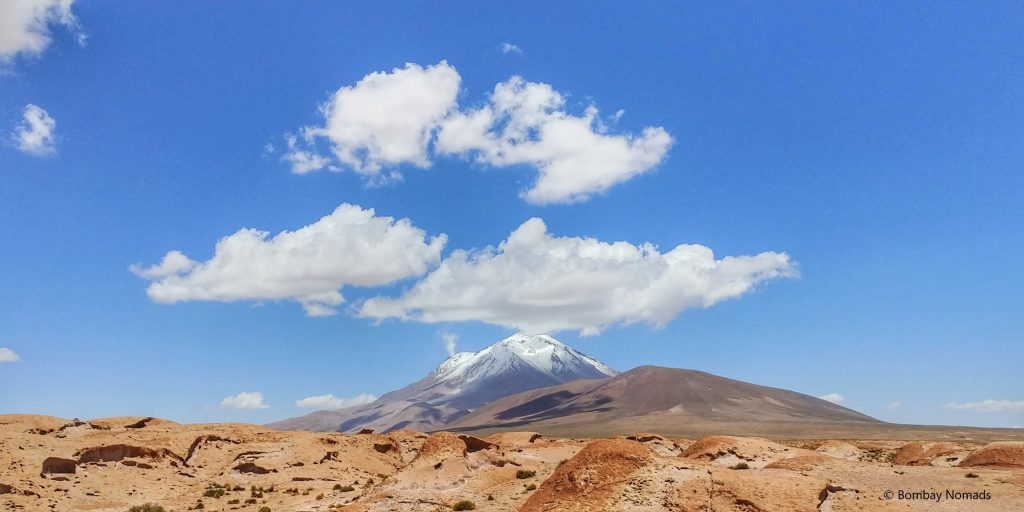
The small lunch room was an extra room in someone’s house and it was a very homely affair. Kids of the household were wandering about as we ate. Lunch was again grilled chicken with salads and rice. Honestly, we had gotten quite bored of grilled chicken by now – and we have had better grilled chicken elsewhere. But what rescued the meal was the fresh mandarin oranges for dessert. I cant remember if oranges had ever felt sweeter.
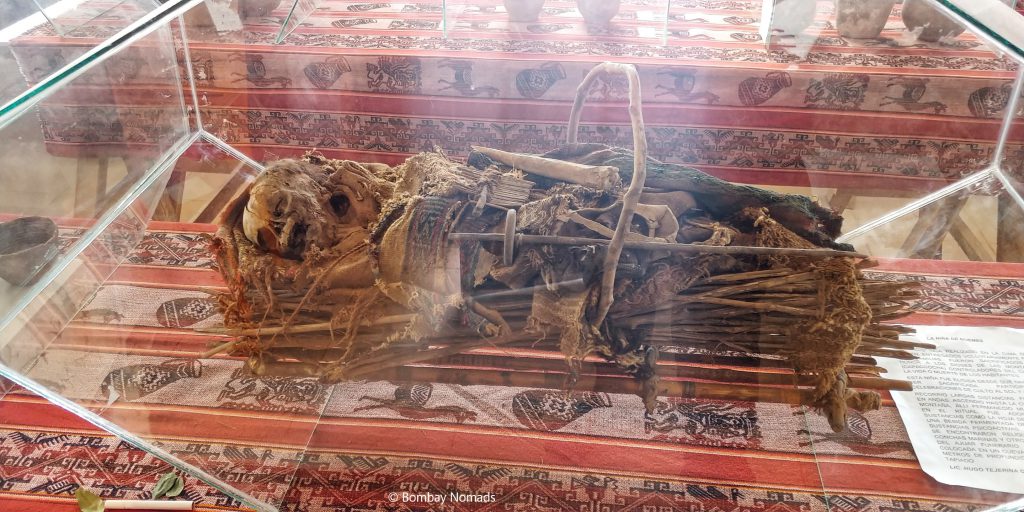
The other surprise was the single room “museum” next door held an Incan child mummy and its grave goods! Incas were known to sacrifice children to volcanoes. This child was put inside a reed basket and left inside the volcano, where the dry air of the antiplano stopped it from completely decomposing. The mummy and all ceramics etc were placed in regular glass cases in this “museum”. There was no sign or air conditioning or dehumidifiers – or any sign of any professional upkeep of this historical artifact.
Ikala
After lunch, we joined what seemed like a semi-regular road, which wasnt metalled, but was somewhat wide and flattened by regular use. For 2 hours, we stuck to this road, which was the Ruta Nacional 5 of Bolivia, and watched the surroundings turn from completely arid, to slightly more green – with quinoa plants growing in places.
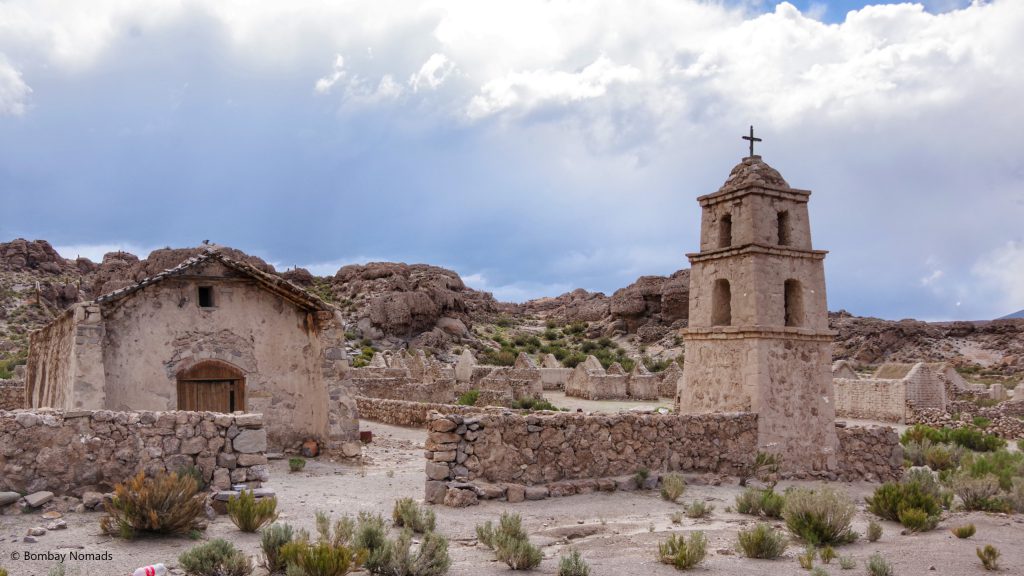
We turned off the road to go towards the abandoned town of Ikala, hidden in the valleys of the nearby volcano. This town was formed by the residents of the village of San Pedro de Quemes, when the village was burned down by the Chilean army, during the Chile-Bolivia war of 1879. Since the town has no good water source, the town was abandoned soon after the war. The roofs of all the houses have collapsed, but the adobe walls remain standing. The church in the centre of the town is still standing, although not in use. The abandoned town feels eerie and super photogenic at the same time. An approaching storm gave the skies vivid colours and made everything even more scenic.
Adventure in Mud
Once we finished exploring the town, we got into our SUV and headed towards the main road. We were driving over open ground, along a rutted trail, when we sunk into a water-filled rut and got stuck, the wheels getting no traction. The ground was muddy due to recent rains and Juan underestimated the depth of the water filled rut. Or he overestimated the ability of 4WD. But we got stuck. Big time!
Juan tried reversing and then going forward, but the car just kept spinning its wheels in the liquified mud. I got down and tried putting stones in front of the tyres, so that we could find some grip there, but we were stuck pretty good. Then Juan ran around, picking up all the pieces of wood he could find, and pushed them under the tyres to give some traction. He dug out the mud in front of the tyres to provide a slope for the car to drive up.
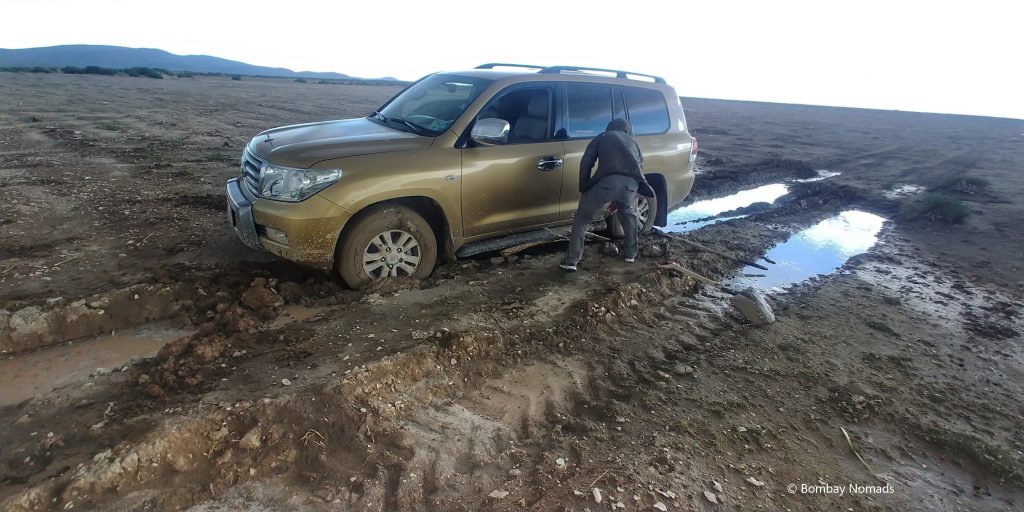
But nothing seemed to help. The car remained stuck. In the meanwhile, the storm that we had seen from Ikala arrived and dumped some rain on us. The ground, which was already soft with water, became softer still. Thankfully the rain did not last long and moved along. Juan ran around and brought more wood, shovelled in front of the tires, brought drier earth from nearby and dumped it in front of the tires – while we pushed from the back. But despite repeating this cycle, the car just seemed to sink deeper in the mud and refused to budge.
After maybe the fifth iteration of wood and dry earth, the car moved about a feet, before sinking again in the mud. Re-energized, Juan did the entire cycle again, positioning wood in front of the tires, digging out a slope, putting dry earth on that slope etc … and finally the car lurched out of the hole and onto more solid ground. We had been stuck for 1.5 hours.
To make sure that we did not get stuck again, Juan went ahead on foot and surveyed the track to see if there were more treacherous portions. He found one more such bog, and there was no way around it. We walked ahead, to reduce the weight of the car, while Juan skillfully speeded up and used momentum to cross this stretch. Thankfully we did not have any other adventures and reached our Tayka hotel at around 18:00.
Day 3 : Kawsay Wasy Necropolis (Lords of Lipes)
Our last stop before reaching Uyuni, was a little known necropolis called Kausay Wasi, outside the unremarkable village of San Juan del Rosario. There are a dozen or so tombs on a small hill outside the village, accompanied by a miniscule museum containing relics from the tombs. We were the only tourists there in the morning – and had to wait a while for the caretaker to show up and open the gates for us.
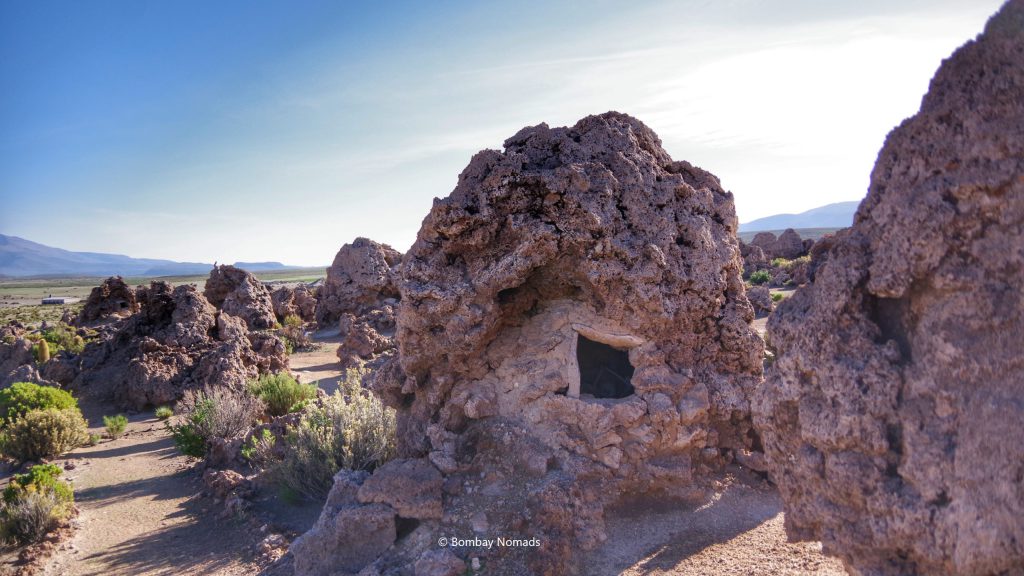
Each tomb is a semi-hemispherical structure like an irregular igloo, made of volcanic tufa rock. They look so natural in the volcanic landscape, that we thought they were little rocky protrusions of the hill itself – till we peeked into the opening of one of them and saw human bones. The dead were wrapped up in a fetal position and some belongings like pottery, food etc were left for them.The tombs were built by the Lipes people, for their noblemen who are referred to as the Lords of Lipes. The Lipes were inhabitants of the region from 1250 to 1450, before the Inca took over the region.
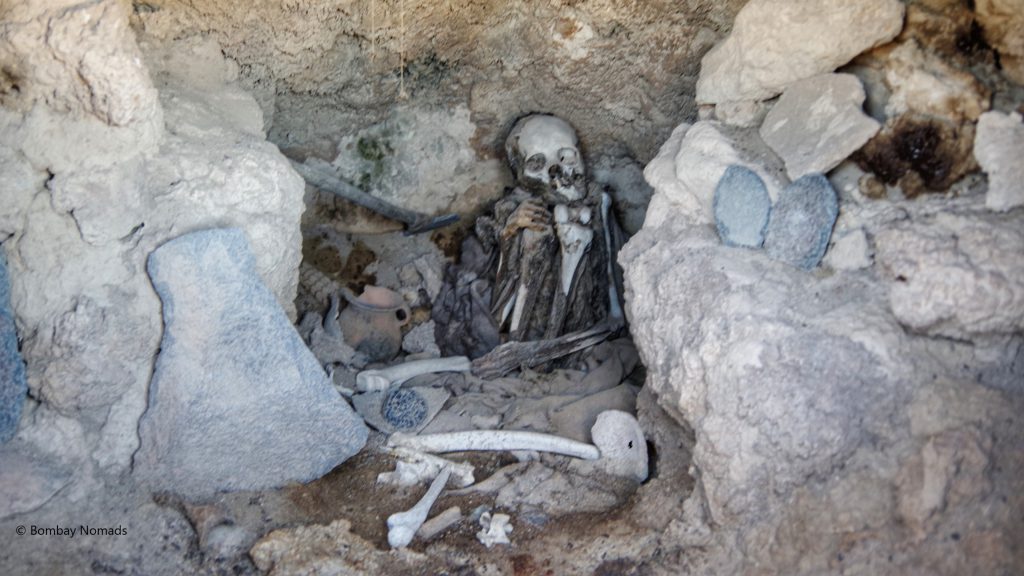
Most of these tombs have been destroyed/looted or collapsed of natural causes. But there are about a dozen or so tombs, which still have their original denizens. A window has been left open on each of these, for tourists to view. Most of the denizens are no longer in the fetal position, as their graves have probably been disturbed – but most skeletons seem intact or at least full. It is surprising at first, and then profoundly interesting to see the bones lie there open to the elements for more than 600 years.
My first thought was, where are the dogs ?
From Kawsay Wasy, we rolled towards the town of Uyuni …
Tayka Hotels
We would be remiss if we skipped describing our hotels in this remote corner of Bolivia. We stayed in 2 different Tayka Hotels in the Eduardo Avaroa National Park area. They are acknowledged as the best options in this remote part of the country – at least in Feb 2019
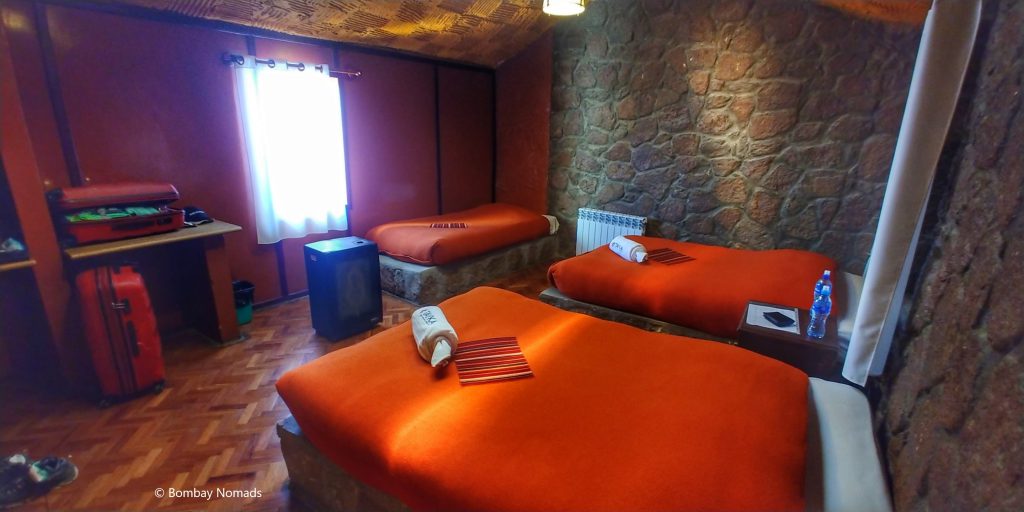
Our first night was in Tayka del Desierto, close to the Siloli desert and Árbol de Piedra. The building is literally in the middle of nowhere, with no hint of human habitation otherwise. The hot water system was solar driven, so we were encouraged to have a shower quickly. The construction was with stone, and a bit rustic, but the rooms were spacious and they had room heaters!
The dinner was the most beautiful part of our stay. The seating is spectacular, with a full glass walls overlooking the setting sun in the desert. We had a lovely 3 course grilled chicken dinner, lit by candlelight and the twilight outside.
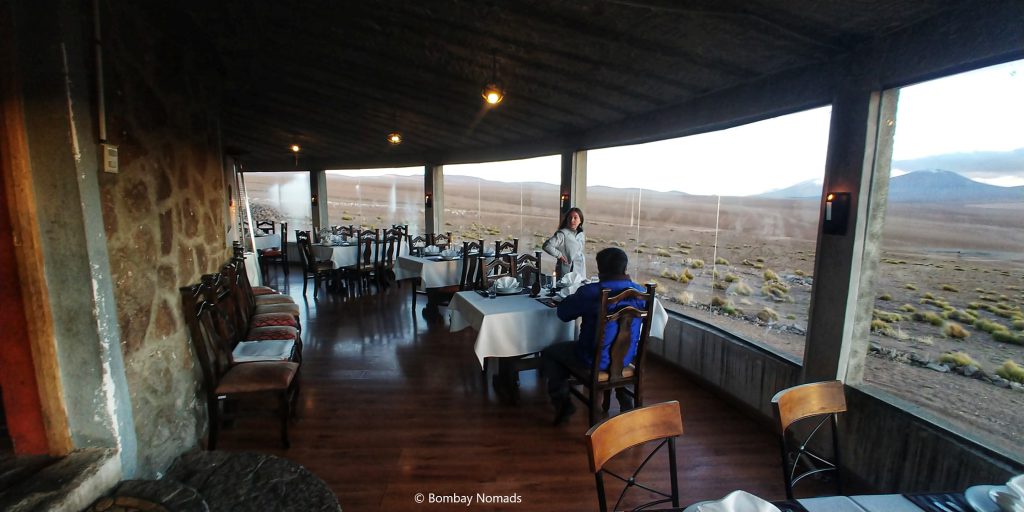
Our second night was at Tayka del Piedro. The rooms were a bit more rustic than the first night, but we got an even bigger room with three beds. The dining room didn’t have such spellbinding views as the day before, but the three course dinner was just as satisfying. Midway through our meal, a huge group of Asian (Japanese?) tourists arrived. And my first thought was – “how did they manage to navigate these empty lands in the darkness ?”
Useful Information
- This is a remote high altitude desert, which is mostly uninhabitable. People who have been to Ladakh and Spiti would understand. Creature comforts and conveniences are very limited, so prepare yourself mentally for it – and carry whatever you need with you.
- Juan, our driver, spoke only Spanish. English speaking drivers in Uyuni cost significantly more. However, after 2 months in the continent, our broken Spanish was manageable and we got along just fine.
- Our car was humongous, and we spent a very comfortable 3 days in it. However, it also made us question HOW do 6 passengers plus driver spend 3 days in it ? We would recommend a 4 passengers + driver configuration for an enjoyable trip
- To take photos of flamingos, you would need proper cameras, as the birds are skittish and stay away from humans. If carrying a DSLR, a zoom of 200mm at the minimum.
- You can never have enough photos of this stunning place. Our photos do not do justice to this phenomenal place.
- Sunglasses and sunscreen are an absolute must on this trip. Although it might be biting cold, the sun at that altitude can be quite damaging.
- Also, the weather and wind can be unpredictable. Always carry extra layers of cold clothing within easy reach
